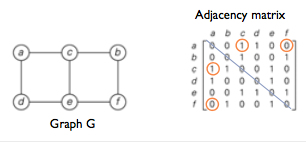Computational Thinking
Table of Contents
Graphs
What is a graph?
a set of vertices (nodes) and a set of edges (arc/arrows) connecting pairs of vertices
consists of a collection V of vertices and collection E of edges, for which we write G = (V, E)
each edge e ∈ E is said to join two vertices (end points) if e joins u, v ∈ V, we write e = (u, v)
V — finite set of vertices E — set of edges (pairs of vertices)
V = {a, b, c, d, e, f}
E = {(a,c), (a,d), (b,c), (b,f), (c,e), (d,e), (e,f)}
Completeness
A graph is complete if you have n vertices and *n-1 *edges on each vertex. Must be simple and undirected.
Edges properties
- connects two vertices
- an edge connecting vertices *i *and j is written as ij
- sometimes has a direction (i —> j)
- weights assigned by means of numbers (e.g. distance between two vertices)
Adjacency Matrix representation
Notation: A[i,j]
Symmetric: A[i,j] = A[j,i]
when a graph is undirected, the adjacency matrix is always symmetric
